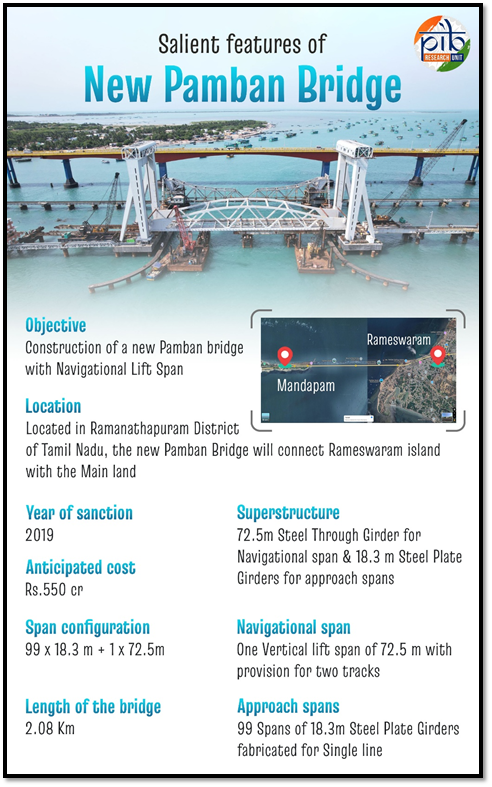New Pamban Sea Bridge Replaces Historic Railway Link
Syllabus:
GS-2:
India and its Neighbourhood , Bilateral Groupings & Agreements , Regional Groupings , Effect of Policies & Politics of Countries on India’s Interests
Focus:
Prime Minister Narendra Modi is set to inaugurate India’s first vertical-lift sea bridge at Rameswaram on April 6. This modern engineering marvel replaces the iconic 110-year-old Pamban railway bridge, restoring crucial connectivity between Rameswaram island and mainland Tamil Nadu after the old structure was closed due to structural damage.
The Legacy of the Pamban Bridge:
A Century-Old Marvel
- The Pamban railway bridge, inaugurated in 1914 under British rule, connected Rameswaram island to the mainland of Tamil Nadu across the Palk Strait.
- It was India’s first sea bridge, spanning 05 km with a manually operated double-leaf bascule span that opened to let ships pass.
- For over a century, it was the only route to the island until a road bridge was added in 1988.
- It survived decades of salt-laden winds, corrosion, and even a deadly cyclone in 1964.
- In December 2022, the bridge was shut down after structural cracks were found.
Sikkandhar – The Sea Pilot
- Ibraahimmal, a resident living 300 meters from the bridge, recalls her father, Sikkandhar, who worked as a sea pilot.
- Ships arriving off the coast would request access; once cleared, Sikkandhar would row out, board the ship, and guide it under the bridge into Pamban harbour.
- The bridge’s spans would split open, saluting the ship’s entry.
- The calm sea, shifting winds, and salt-laden air were daily challenges he faced.
Engineering Heroics: The Cyclone of 1964
- The 1964 cyclone flattened Dhanushkodi, destroyed 126 of the bridge’s 146 spans, and twisted the structure.
- Sreedharan, then a 32-year-old engineer, restored the bridge in just 46 days, a task originally estimated to take six months.
- His team salvaged sunken steel girders and innovated with floating cranes.
- This became one of the most defining projects of his career.
About Old Pamban Bridge:● What it was: A historic railway bridge connecting Rameswaram Island to Mandapam (mainland Tamil Nadu). ● Built in: 1914 by British India under Madras Railway; construction completed in 2.5 years. ● Location: Spans the Palk Strait between Mandapam and Rameswaram (Pamban Island), Tamil Nadu. ● Historical Significance: ○ India’s first sea bridge and the only one until the Bandra-Worli Sea Link in 2010. ○ Crucial for pilgrims, trade, and connectivity to the island. ● Design Features: ○ Type: Double-leaf bascule bridge with a Scherzer lift span. ○ Mechanism: Manually operated levers lifted both sides (leaves) of the span to allow ship movement. ○ Length: 2.065 km with 143 piers; 12.5 meters above sea level. ● Lifespan: Operated for 108 years before being closed in 2022 due to corrosion and structural damage. About New Pamban Bridge: ● Constructed by: Rail Vikas Nigam Limited (RVNL) ● Cost: ₹531 crore ● Inauguration Year: 2025 ● Modern Features: ○ India’s first vertical lift sea bridge ○ 72 m lift span allows larger ships to pass smoothly ○ Automated operation via electro-mechanical systems ● Sustainability & Durability: ○ Uses corrosion-resistant materials ○ Solar-ready design for future energy efficiency ● Length: Approx. 2.2 km, taller and wider than the old bridge ● Advantage: Faster, stronger, safer, and more sustainable, designed for next-generation needs Key Differences :
|
Bridge to the Future: The New Vertical Lift Bridge
Modern Engineering Replaces a Relic
- On April 6, Prime Minister Narendra Modi is set to inaugurate India’s first vertical lift sea bridge, replacing the old structure.
- Constructed by Rail Vikas Nigam Limited (RVNL) at a cost of ₹535 crore.
- It is built using steel and reinforced cement concrete, three metres taller than the old bridge.
Key Features
- Spans 078 km across the Palk Strait with 100 spans.
- The main navigational span is 5 metres long, capable of lifting vertically up to 17 metres to allow ships to pass.
- Fully automated with electro-mechanical systems synced to train signals.
- Symbolizes the shift from manual levers to digital code, maintaining the legacy of carrying pilgrims, workers, and stories.
Personal Tales: People of the Bridge
Generations Bound to the Bridge
- Muhammad Meerasa, Ibraahimmal’s husband, was a lift operator on the old bridge’s bascule span.
- 16 men manually operated the bridge, cranking it open using large levers — a job that required both strength and coordination.
- When Meerasa retired, he passed the job to his son, continuing the legacy.
The Bridge Inspector’s Legacy
- Allappiccha, another operator, started as a track checker.
- His father died a day before retirement, and Allappiccha inherited his job — and with it, the bridge.
- Though initially illiterate, he learned to read registers with help from his children.
- Now working in the Bridge and Rail Infrastructure wing, he says, “To lift a bridge, you need not just strength but to understand what the numbers say.”
The Train: Rameswaram’s Lifeline
More Than Just Transport
- Trains were arteries of survival — ferrying water, goods, school children, and connecting islanders to mainland life.
- Trains like the “Pallikkoodath Vandi” (school train) echoed with the laughter of children.
- Local trade thrived — jasmine flowers, curry leaves, dried fish were transported to far-off markets like Chennai and North India.
The Legendary Boat Mail
- The Boat Mail Express once connected Madras to Colombo.
- Passengers would disembark at Dhanushkodi, take a steam ferry to Talaimannar (Sri Lanka), then continue to Colombo.
- This seamless Indo-Lanka connection was a hallmark of earlier decades.
Stories from the Tracks
- Baala, a young man from Madurai in the 1970s, crawled across the bridge during a storm to deliver a passport — later founding Madurai Travels.
- The bridge also carries darker memories — espionage during the Sri Lankan civil war, and the tragedy of the 1964 cyclone.
Remembering the 1964 Cyclone & Cultural Memory:
A Night of Destruction
- On December 22, 1964, Train No. 653 left Pamban station and was swept away by a colossal wave near Dhanushkodi.
- 110 passengers and 5 railway staff perished; over 200 residents also lost their lives.
- Dhanushkodi was declared uninhabitable — it remains a ghost town today, drawing tourists and mourners.
Survival and Stories
- Ibraahimmal recounts how two bridge operators tied themselves with iron ropes to survive that night’s wrath.
- Her father also saw actors Sivaji Ganesan and Savitri stranded post-cyclone, unable to return from their temple visit.
Living with Memory
- Peter Bernard, a fisherman, reflects while watching the new bridge: “If the train moves, we move.”
- For Rameswaram’s residents, the bridge is not just steel and bolts, but a repository of generational memory, faith, and identity.
Conclusion: A Bridge of Time
- The story of the Pamban bridge is a tale of engineering, resilience, and people.
- As the old bridge rests and the new one rises, the sea remains the same — only the tools have changed.
- In every span lies a story, and in every bolt, a memory — this bridge is not just a structure but a living archive of India’s coastal heart.
Source: IE
Mains Practice Question:
The new Pamban sea bridge represents both technological advancement and historical continuity. Discuss its strategic, economic, and cultural significance. How do infrastructure projects like this balance heritage preservation with modernization?





